Last Updated on January 19, 2024 by Greg Gillson
What birds come to feeders in winter?
In general, birds that eat seeds come to feeders in winter. These include finches, chickadees, sparrows, nuthatches, cardinals, jays, goldfinches, juncos, doves, grosbeaks, titmouses, starlings, and siskins.
Birds that eat suet also come to feeders in winter: woodpeckers, bushtits, wrens, warblers, and kinglets.
This is part two that began with the article: Secrets to feeding birds in winter.
That other article discusses how to set up your winter feeders to attract the most birds.
These 10 species are the most widespread birds that come to feeders in winter across the US:
- Dark-eyed Junco
- Mourning Dove
- Downy Woodpecker
- House Finch
- American Goldfinch
- White-breasted Nuthatch
- White-crowned Sparrow
- House Sparrow
- European Starling
- Song Sparrow
Following are over 40 of the most common birds in winter in the United States. I provide a very brief comment about their identification. Then I give a general idea of their winter range. I tell what their favorite food is in winter, and what type of bird feeder they prefer.
Birds that come to feeders in winter throughout most of the United States
This next section lists birds that may be found at most bird feeders across the US in winter.
It is likely that many of these birds come to your bird feeder, nearly wherever you live in the United States.
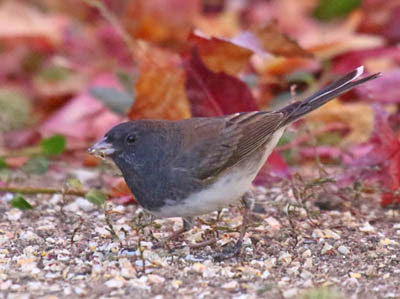 |
| Dark-eyed Junco. Greg Gillson. |
Dark-eyed Junco
Brief identification: This tiny bird has a little pink bill. Various forms have black or pale gray heads with brown back. Others are all dark slate gray. All forms have flashing white outer tail feathers.
Winter range: Southern Alaska across southern Canada, southward to northern Mexico and all of the U.S except for Florida and southern Texas.
Foods and feeder types: Dark-eyed Juncos eat small mixed seeds, white millet, from platform and hopper feeders, or even just on the ground.
 |
| Mourning Dove. Greg Gillson. |
Mourning Dove
Brief identification: These larger backyard birds are tan-colored and have long pointed tails.
Winter range: Most of United States, except northern Great Plains and Northern Rocky Mountain region, south through Mexico.
Foods and feeder types: Mourning Doves eat many grains and seeds: cracked corn, black oil sunflower seeds. They prefer platform feeders or on ground.
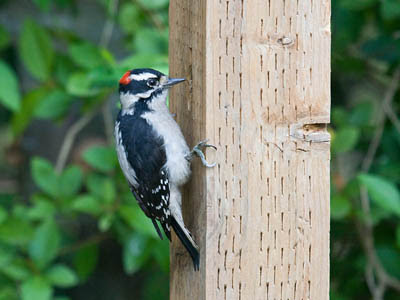 |
| Downy Woodpecker. Greg Gillson. |
Downy Woodpecker
Brief identification: Tiny black-and-white woodpecker.
Winter range: Resident in Alaska and Canada and most of United States except for deserts.
Foods and feeder types: Downy Woodpeckers eat suet from suet feeders.
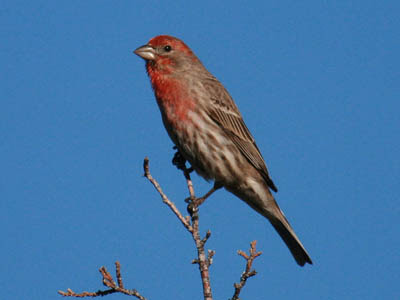 |
| House Finch. Greg Gillson. |
House Finch
Brief identification: Small dusty-brown bird with broad streaks on under parts. Male with red forehead, breast, rump. Flocks.
Winter range: Year-round resident across southern Canada and the United States into Mexico.
Foods and feeder types: House Finches eat black oil sunflower seed from tube feeders.
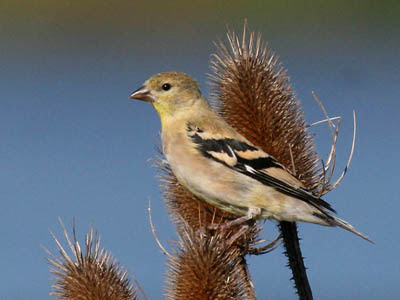 |
| American Goldfinch. Greg Gillson. |
American Goldfinch
Brief identification: Tiny bird. Winter plumage is gray or tan with yellow throat. Dark wings with broad pale wing bars.
Winter range: In winter found across the United States.
Foods and feeder types: American Goldfinches eat Niger seed from thistle feeders, also black oil sunflower seeds from tube feeders.
 |
| White-breasted Nuthatch. Greg Gillson |
White-breasted Nuthatch
Brief identification: Very short tailed bird climbing on branches and tree trunks. Blue-gray above, white below.
Winter range: Deciduous and pine trees across Canada and most of the United States except deserts.
Foods and feeder types: White-breasted Nuthatches eat black oil sunflower seeds, nuts, from any type of feeder.
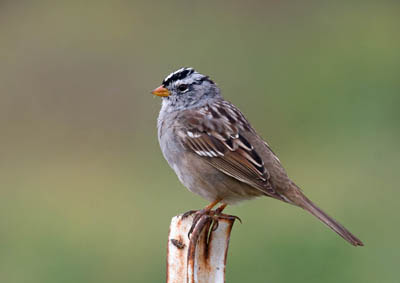 |
| White-crowned Sparrow. Greg Gillson. |
White-crowned Sparrow
Brief identification: Large long-tailed sparrow with gray and brown striped back. Black-and-white head stripes.
Winter range: In winter found along West Coast and middle latitude and southern parts of the United States.
Foods and feeder types: White-crowned Sparrows eat millet and mixed seeds on ground or low platform feeders.
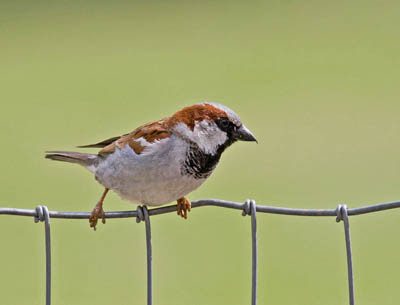 |
| House Sparrow. Greg Gillson. |
House Sparrow
Brief identification: Smaller brown sparrow with plain breast. Male with gray crown and black throat. Flocks.
Winter range: Resident across most of Canada and the United States.
Foods and feeder types: House Sparrows eat mixed seeds on hopper and platform feeders. Sometimes an unwelcome feeder guest.
 |
| European Starling. Greg Gillson. |
European Starling
Brief identification: Shorter tailed black bird. Often in large flocks.
Winter range: Southern Canada and the United States.
Foods and feeder types: European Starlings eat sunflower seeds from platform and hopper feeders. Also eat suet at suet feeders. Sometimes an unwelcome feeder guest.
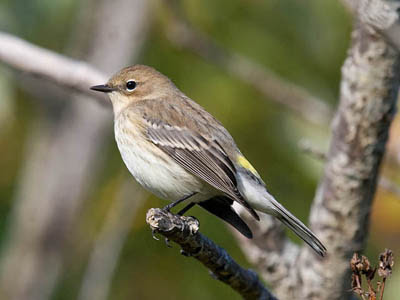 |
| Yellow-rumped Warbler. Greg Gillson. |
Yellow-rumped Warbler
Brief identification: Winter plumage is pale brown above, dusky breast, white belly. Yellow rump.
Winter range: Coastal and southern parts of the United States.
Foods and feeder types: Yellow-rumped Warblers eat suet at suet feeders.
 |
| Ruby-crowned Kinglet. Greg Gillson. |
Ruby-crowned Kinglet
Brief identification: Tiny round green bird with short tail. White wing bars.
Winter range: Both coasts of the United States and southern states.
Foods and feeder types: Ruby-crowned Kinglets eat suet at suet feeders.
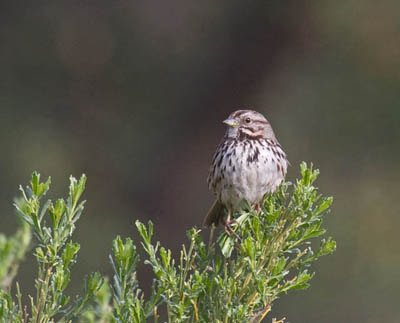 |
| Song Sparrow. Greg Gillson. |
Song Sparrow
Brief identification: Streaked gray, light brown, and dark brown above and on head. White under parts heavily streaked, forming a dense spot on the upper breast.
Winter range: Most of United States. Absent from extreme northern Northeast, extreme northern Midwest, and extreme northern Great Plains.
Foods and feeder types: Song Sparrows eat millet, black oil sunflower, and mixed seeds from ground and low platform feeders.
 |
| Eurasian Collared-Dove. Greg Gillson. |
Eurasian Collared-Dove
Brief identification: Large cream-colored pigeon with square tail. Black collar mark on the hind neck. Dark under tail coverts.
Winter range: Has expanded explosively across the continent from Florida in the last 35 years. Found throughout much of the United States; least common in the Northeast.
Foods and feeder types: Eurasian Collared-Doves eat black oil sunflower seeds, cracked corn, and other grains from platform feeders.
Birds at feeders in winter in the northern United States
The birds in this section occur across the northern tier of states. Some of these undergo irruptions far to the south during years of poor cone crop production in the north.
 |
| Evening Grosbeak. Greg Gillson. |
Evening Grosbeak
Brief identification: Larger plump finch with thick bill. Dusky merging into yellow. Female grayer rather than yellow. Wings with large white wing patches.
Winter range: Southern Canada, northern tier of United States, mountains of the West. Irregularly south across much of the United States.
Foods and feeder types: Evening Grosbeaks eat black oil sunflower seeds from hopper and platform feeders.
 |
| Pine Siskin. Greg Gillson. |
Pine Siskin
Brief identification: Very small brown streaked bird. Yellow wing stripe in flight.
Winter range: Coastal Alaska, southern Canada, most of the United States.
Foods and feeder types: Pine Siskins eat Niger seed from thistle feeders. They also eat shelled sunflower seeds from hopper feeders.
 |
| Purple Finch. Greg Gillson. |
Purple Finch
Brief identification: Brown above, male with reddish wash on back. Top of crown red. Under parts reddish with no streaks on breast of male. Female heavily streaked below, pale eyebrow wrapping around ear coverts. Compare with House Finch.
Winter range: Eastern United States and also West Coast, adjacent southern Canada.
Foods and feeder types: Purple Finches eat black oil sunflower seeds at hopper and tube feeders.
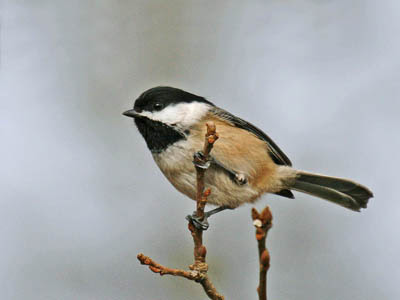 |
| Black-capped Chickadee. Greg Gillson. |
Black-capped Chickadee
Brief identification: Gray above, white below with buffy flanks. Black crown and bib contrast with white face.
Winter range: Alaska, Canada, northern half of the United States.
Foods and feeder types: Black-capped Chickadees eat black oil sunflower seeds from tube and hopper feeders.
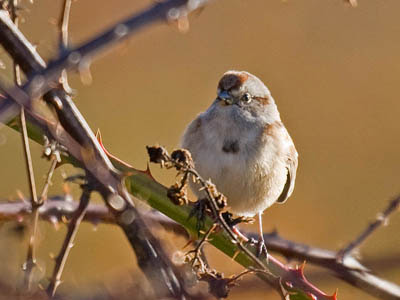 |
| American Tree Sparrow. Greg Gillson. |
American Tree Sparrow
Brief identification: Small gray and buffy sparrow with chestnut crown and striped back. Dark central breast spot.
Winter range: Rural extreme southern Canada and northern United States: Maine to West Virginia, westward to Idaho, northern Nevada.
Foods and feeder types: American Tree Sparrows eat black oil sunflower seeds and millets seeds from hopper and platform feeders.
Winter birds that come to feeders in the eastern United States
Most of these birds occur from the edge of the Rocky Mountains to the East Coast. Others are more restricted toward the Southeastern United States.
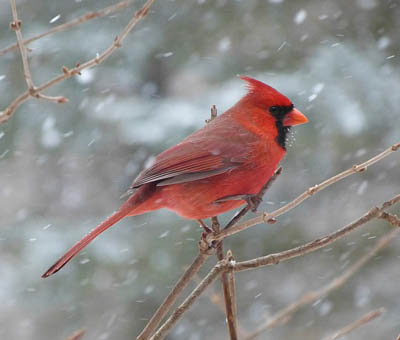 |
| Northern Cardinal. tlparadis from Pixbay |
Northern Cardinal
Brief identification: Bright red (males) with crest. Females tan.
Winter range: Extreme southern Canada in the east. All of eastern United States from Atlantic to Dakotas and south to Texas, Florida. Also Arizona.
Foods and feeder types: Northern Cardinals eat safflower and sunflower seeds from platform or larger hopper feeders.
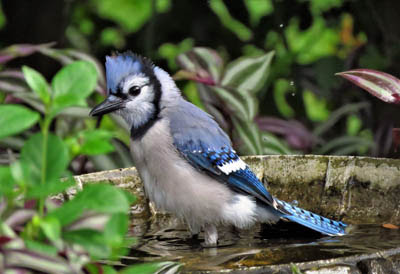 |
| Blue Jay. skeeze from Pixabay |
Blue Jay
Brief identification: Blue above, white below with blue crest, black necklace, white wing patches.
Winter range: East of the Rocky Mountains, across southern Canada, all of Eastern United States west to Texas.
Foods and feeder types: Blue Jays eat sunflower seeds from hopper feeders, nuts and peanuts from platform feeders, and suet from suet feeders.
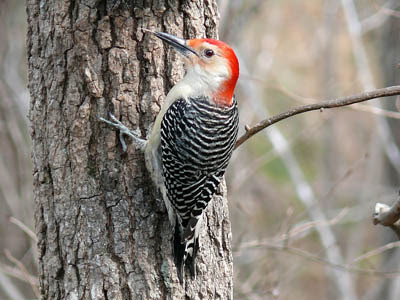 |
| Red-bellied Woodpecker. skeeze from Pixabay. |
Red-bellied Woodpecker
Brief identification: Pale gray with black-and-white barred back and red crown.
Winter range: Eastern United States, west to the Dakotas, Texas. Rare near the Canadian border.
Foods and feeder types: Red-bellied Woodpeckers eat nuts and peanuts from platform feeders and suet from suet feeders.
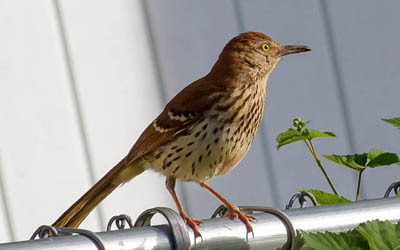 |
| Brown Thrasher. Linda Jones CC0 from Pixabay. |
Brown Thrasher
Brief identification: Large brown bird with large tail. Long pointed curved bill. Heavily streaked below.
Winter range: Southeast, Maryland to Texas.
Foods and feeder types: Brown Thrashers eat suet at suet feeders and some sunflower seeds from platform feeders.
 |
| Pine Warbler. skeeze from Pixabay. |
Pine Warbler
Brief identification: Olive upper parts and face. White wing bars. Yellow throat and breast, white belly and under tail. Long tail. Thin bill.
Winter range: Southeast.
Foods and feeder types: Pine Warblers eat suet at suet feeders and sunflower seeds at hopper feeders.
 |
| Tufted Titmouse. Anne773 from Pixabay. |
Tufted Titmouse
Brief identification: Small stocky gray bird with a crest.
Winter range: Most of the Eastern United States west to Minnesota and Texas.
Foods and feeder types: Tufted Titmouses eat black oil sunflower seeds and peanuts from any feeder type.
 |
| Carolina Chickadee. GeorgeB2 from Pixabay. |
Carolina Chickadee
Brief identification: Small bird with long tail. Gray above. Black cap and bib.
Winter range: Southeastern United States west to Texas.
Foods and feeder types: Carolina Chickadees eat black oil sunflower seeds from any type of feeder, and suet from suet feeders.
 |
| White-throated Sparrow. Greg Gillson. |
White-throated Sparrow
Brief identification: Brownish above, gray below with contrasting white throat. Black-and-white striped head with yellow spot above the front of the bill.
Winter range: East and Southeast United States from New York to New Mexico and southern Arizona. Rare throughout the West.
Foods and feeder types: White-throated Sparrows eat millet and mixed seeds including black oil sunflower seeds from ground or platform or hopper feeders.
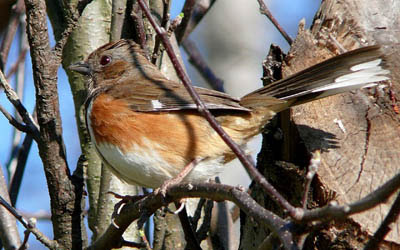 |
| Eastern Towhee. skeeze from Pixabay. |
Eastern Towhee
Brief identification: Large sparrow with black upper parts, white belly, rusty sides. Red eyes.
Winter range: Primarily the Southeast, but New Jersey to Missouri, Texas.
Foods and feeder types: Eastern Towhees eat millet and black oil sunflower seeds from platform and hopper feeders.
 |
| Carolina Wren. theSOARnet from Pixabay. |
Carolina Wren
Brief identification: Brown above, paler buffy below. White-eyebrow stripe. Long curved pointed bill. Long floppy tail.
Winter range: Eastern United States with the northern and western edge of the range from southern Maine to Iowa to Texas.
Foods and feeder types: Carolina Wrens eat suet from suet feeders.
Winter feeder birds in the western United States
The following birds are found at bird feeders in the West, from the Rocky Mountains westward.
Most of these do not occur in the desert southwest unless otherwise noted.
 |
| Red-breasted Nuthatch. Greg Gillson. |
Red-breasted Nuthatch
Brief identification: Small with very short tail. Blue-gray above, rich cinnamon below.
Winter range: Southeast Alaska, across southern Canada, and nearly all of the United States. During some winters, the birds move farther south than other winters.
Foods and feeder types: Red-breasted Nuthatches eat black oil sunflower seeds from hopper and tube feeders.
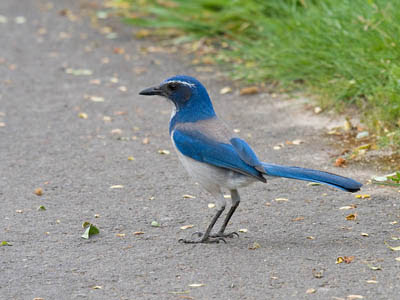 |
| California Scrub-Jay. Greg Gillson. |
California Scrub-Jay
Brief identification: Blue above and white below with blue partial necklace.
Winter range: West Coast from western Washington south into Baja California.
Foods and feeder types: California Scrub-Jays eat nuts and peanuts, sunflower seeds from platform and hopper feeders. They also eat suet from suet feeders.
 |
| Steller’s Jay. Greg Gillson. |
Steller’s Jay
Brief identification: Dark blue with black head and crest.
Winter range: The West, from southern Alaska to southern California, New Mexico, into Mexico.
Foods and feeder types: Steller’s Jays eat nuts and peanuts and sunflower seeds from platform and hopper feeders. They also eat suet from suet feeders.
 |
| Golden-crowned Sparrow. Greg Gillson. |
Golden-crowned Sparrow
Brief identification: Large, long sparrow, brown above, buff below. Dark forehead with yellow crown.
Winter range: SW Canada to southern California.
Foods and feeder types: Golden-crowned Sparrows eat black oil sunflower seeds and mixed seeds from platform and hopper feeders.
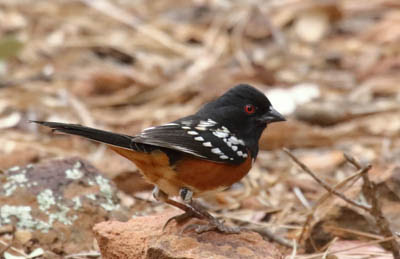 |
| Spotted Towhee. Greg Gillson. |
Spotted Towhee
Brief identification: Black upper parts, white belly, rusty sides. Red eye. White spots on wing coverts and tail corners.
Winter range: West Coast, southern Great Plains south to Texas.
Foods and feeder types: Spotted Towhees eat millet, mixed seeds, and sunflower seeds from the ground and platform feeders.
 |
| Chestnut-backed Chickadee. Greg Gillson. |
Chestnut-backed Chickadee
Brief identification: Chestnut back with gray wings. Black cap and bib contrast with white face.
Winter range: Coastal Alaska south to San Francisco, California. Also northern Idaho and nearby mountains.
Foods and feeder types: Chestnut-backed Chickadees eat black oil sunflower seeds from tube and hopper feeders. They also eat suet from suet feeders.
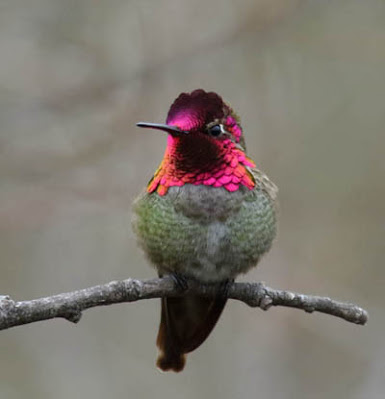 |
| Anna’s Hummingbird. Greg Gillson. |
Anna’s Hummingbird
Brief identification: Large green hummingbird, gray-green belly. Males with iridescent rose-pink covering entire head.
Winter resident: Non-migratory, year-round resident from SW British Columbia to southern California, Arizona.
Foods and feeder types: Anna’s Hummingbirds eat sugar nectar from hummingbird feeders.
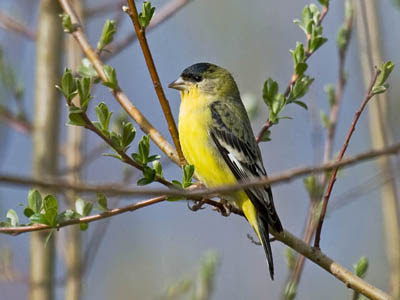 |
| Lesser Goldfinch. Greg Gillson. |
Lesser Goldfinch
Brief identification: Yellow under parts, greenish (or black) upper parts). Black wings with white wing bars. Black tail.
Winter range: West from southern Washington to western Texas, through Mexico.
Foods and feeder types: Lesser Goldfinches eat Niger seed from thistle feeders and black oil sunflower seeds from tube feeders.
 |
| Bushtits. Greg Gillson. |
Bushtit
Brief identification: Tiny gray bird with long tail. Usually in flocks.
Winter range: SW British Columbia southward into Mexico and eastward to Texas.
Foods and feeder types: Bushtits eat suet at suet feeders.
 |
| Bewick’s Wren. Greg Gillson. |
Bewick’s Wren
Brief identification: Brown above, pale gray below, white eyebrow. Long floppy barred tail.
Winter range: SW British Columbia south into Mexico, east to Missouri, Texas.
Foods and feeder types: Bewick’s Wrens eat suet at suet feeders.
 |
| Townsend’s Warbler. Greg Gillson. |
Townsend’s Warbler
Brief identification: Gray tail and wings with white wing bars. Green back. Black crown, ear coverts. Yellow face and breast (male with black throat) with black streaks on sides.
Winter range: West Coast of United States into Mexico.
Foods and feeder types: Townsend’s Warblers eat suet at suet feeders.
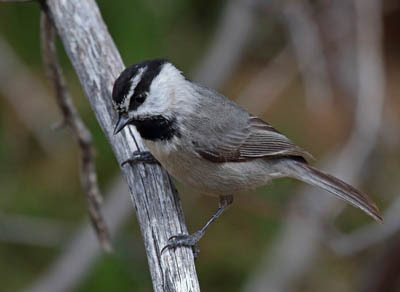 |
| Mountain Chickadee. Greg Gillson. |
Mountain Chickadee
Brief identification: Gray above, paler gray below with black bib. Black cap with white eyebrow.
Winter range: Mountains from western Canada to southern California, extreme western Texas, into Mexico.
Foods and feeder types: Mountain Chickadees eat black oil sunflower seeds from tube feeders.
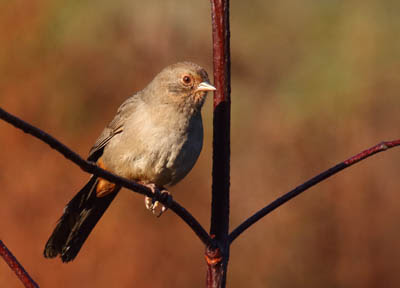 |
| California Towhee. Greg Gillson. |
California Towhee
Brief identification: Large unstreaked brown sparrow with rusty under tail coverts.
Winter range: California into Baja, Mexico.
Foods and feeder types: California Towhees eat black oil sunflower seeds, millet and mixed seeds on platform feeder or ground.
Wrapping Up
Bird watching at bird feeders particularly in winter offers a surprisingly rich blend of benefits for both your physical and mental well-being. Here are just a few reasons why it’s such a good thing for you:
Observing the beauty and calming movements of birds can lower cortisol levels and reduce stress hormones. The repetitive chirping and songs act as a natural form of white noise, blocking out distractions and promoting relaxation and the simple act of stepping outside and focusing on nature can take your mind off worries and anxieties.
Watching birds interact and play can trigger the release of dopamine and serotonin, neurotransmitters associated with happiness and well-being. The sense of wonder and awe inspired by these feathered friends can elevate mood and foster a sense of connection to nature.
Bird watching can also be a mindful activity, promoting present-moment awareness and appreciation for the small joys in life.
It is even good for your brain!
Identifying different bird species, learning their calls and behaviors, and keeping track of who visits your feeder can stimulate the brain and improve memory. Observing their intricate social interactions and problem-solving skills can foster curiosity and encourage creative thinking.
Frequently Asked Questions
What is the best thing to put out for birds in the winter?
Choosing the best food for winter birds depends on several factors, including the types of birds you want to attract and the local climate. Here are some excellent options to consider:
Black-oil sunflower seeds: These are packed with nutrients and oil, perfect for keeping birds warm in cold weather. Most birds love them, making them a versatile choice.
Suet cakes: Melted suet mixed with nuts, seeds, and fruits provides a rich energy source, especially appealing to woodpeckers, chickadees, and nuthatches. Choose suet cakes without raisins or grapes, as they can ferment and harm birds.
Peanuts: Unsalted and shelled peanuts are another high-energy treat, attracting jays, woodpeckers, and other larger birds. Avoid whole peanuts that smaller birds can’t crack.
Nyjer seeds: These tiny, oil-rich seeds are favorites of finches and goldfinches. Offer them in specific finch feeders with small mesh.
How do I attract birds to my bird feeder in the winter?
Attracting feathered friends to your winter bird feeder requires a little planning and effort, but the rewards are plentiful! Here are some tips to make your feeder irresistible:
Offer high-energy foods: Black-oil sunflower seeds, suet cakes, and peanuts are packed with fats and oils, crucial for maintaining birds’ body temperature in winter. Choose unsalted and raw options whenever possible.
Variety is key: Don’t just rely on one type of food. Provide a mix of seeds like millet, safflower, and cracked corn, along with fruit pieces like apples or oranges, to cater to different birds’ preferences.
Think small: Tiny finches adore Nyjer seeds. Offer them in dedicated feeders with small mesh to prevent larger birds from hogging them.
Replenish regularly: Empty feeders will leave birds disappointed and searching elsewhere. Keep them well-stocked, especially during harsh weather periods.
How do small birds not freeze in winter?
Despite their tiny size, small birds employ a surprisingly robust toolkit to survive the harsh winter months. Here are some key tactics that keep them from freezing:
High metabolism: Tiny bodies mean rapid fire. Their metabolic rate soars in winter, burning food at a higher rate to generate heat. They might eat up to three times their weight in seeds and other food daily!
Insulation: Feathers are nature’s down jackets. Fluffing their feathers traps pockets of air close to their body, creating a barrier against the cold. Some species even add an extra layer of fluffy underfeathers for increased insulation.
Reducing heat loss: They conserve precious heat by minimizing exposed surfaces. Small bills and feet lose less heat compared to larger ones. Some birds even tuck their feet into their feathers when standing.
Seeking shelter: During extreme cold, they seek refuge in sheltered hollows, crevices, or birdhouses. Huddling with other birds for warmth is also common, especially among social species.
Behavioral adaptations: They minimize unnecessary activity to conserve energy. Shivering is a last resort, as it’s energetically expensive. Instead, they may sunbathe, stand on one leg to minimize heat loss from the other, or tuck their head under their wing.
Adapting diet: Winter diet shifts towards high-fat and high-calorie foods like sunflower seeds, nuts, and suet. These provide concentrated energy reserves to fuel their internal furnace.
Anti-freeze adaptations: Some bird species like chickadees have special proteins in their blood that act like antifreeze, preventing ice crystals from forming and damaging their cells.
Related Articles:
See Part One: Secrets to feeding birds in winter
What seeds different birds like to eat.
Birds that come to feeders in summer
Why fall might be the best time to set up your feeders






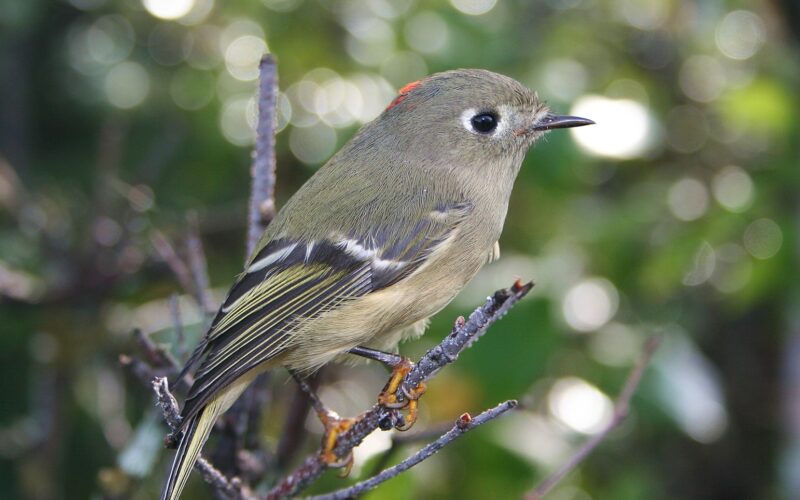
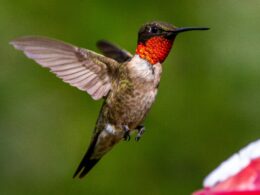
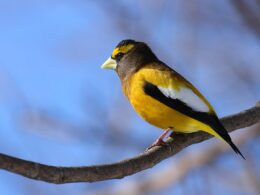
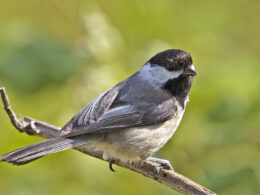
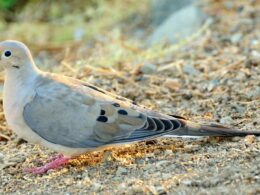
My wife has become an avid birder and is off looking today. I try to join her hobby by better knowing the backyard birds at a minimum. This is a very accessible list for someone not as resourced as his spouse!
Good job! I'm sure your efforts will be appreciated.
I seem to have lost all my house finches even though I've scattered seed on the ground all over our small orchard. They used to visit in large numbers but this winter, they're nowhere to be found. I have plenty of goldfinches at my hanging feeders. I live in the central valley in CA. We had several trees trimmed pretty severely in January, too. But there are still plenty of other trees for roosting (2 orange + a plum) in and around our yard.
I forgot to check the notify me box for the above post about my house finches…
Dear ScatteredWriter,
Thanks for visiting!
I haven't heard of missing House Finches from anyone else. That truly is strange, as these birds are pretty much common all year.
My guess is that it just a local phenomenon–they may have moved nearby for some reason.
In Washington State the Pine Siskins are undergoing an epidemic that spreads at feeders. So feeding at feeders is discouraged for all birds until this outbreak runs its course. This is not unusual finches that flock to feeders in winter.
It's possible something similar is happening in your area. But then you'd be seeing sick birds at the feeder, not no birds.
A mystery!